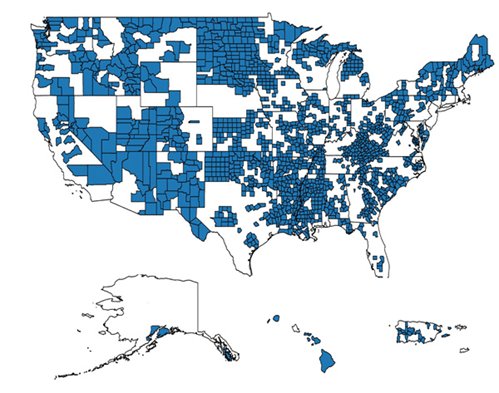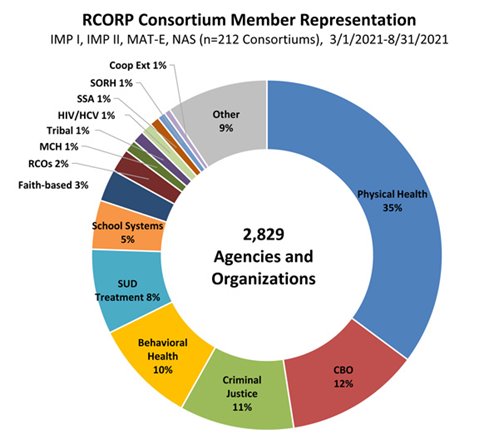Building sustainable rural substance use disorder partnerships
Recruiting, engaging, and retaining member agencies can be challenging due to agency competition, differences in belief systems, stigma, and a workforce already stretched to the limit. Nonetheless, more than 550 rural consortiums have been created since RCORP’s inception, working on behalf of their
communities. Through qualitative interviews as part of RCORP’s evaluation process, several anonymous consortium leaders shared insights into how to develop partnerships and facilitate collaboration and cooperation among agency members in the hopes of easing the learning curve for new consortiums.
 |
Bringing the right people to the table
Forming a consortium takes work and time to make it gel. The basis of that formation is the needs assessment or strategic plan, which is used to understand what service sectors are critical and to guide an environmental scan of existing resources. Recruitment is most productive when consortium leads leverage existing relationships, utilize new members’ networks, and are clear about goals and expectations.
“We look at our community. We call it our ‘local scavenger hunt.’ What do we have in this community that we are unaware of? And let us seek those places out and bring them to the table,” says one consortium leader.
While not everyone has the time to commit and certain service sectors can be difficult to recruit and engage despite their ability to be a facilitator of or barrier to SUD/OUD service delivery (such as law enforcement or a faith-based community), agencies do join when they understand what the consortium is trying to accomplish, when they see themselves as part of the solution, and when there is shared support for all members’ goals. Currently, there are more than 2,800 distinct agencies across 212 consortiums within four active RCORP cohorts addressing SUD/OUD in rural communities.
Initial period of adjustment
Consortium leads noted that an adjustment period is common as consortium members build trust and learn how best to work together. Structure (such as meetings and tasks) is critical to ensure members know what is expected of them, that nothing important is overlooked, and that everyone is engaged.
“I would say it took us a solid year…of building trust, getting used to working with each other, getting on the same page with priorities and that kind of thing,” says another consortium leader. “It was a long process at the beginning. But now I feel like we are able to really quickly make decisions and do things together.”
Understanding and addressing member concerns, periodically meeting one-on-one, and fostering a group dynamic that is open to new ideas is key to initial and ongoing member engagement.
 |
Working together as a consortium
Consortium maturation is guided by a deliberative process that structures work, creates cooperation between members, and ensures members see benefits of participation. Working groups and subcommittees prioritize, manage, and accomplish an array of consortium tasks or projects. A skilled facilitator or manager oversees consortium operations, keeps tasks on track, and structures meetings and communication to efficiently utilize members’ time.
“And then there is supporting each other in the initiatives that you have. During our meetings we would invite everyone to tell us what they were doing and how they wanted us to support or collaborate with them. And that was helpful,” a consortium leader reports.
As consortiums mature, communities change, and needs assessments are updated, membership rosters adjust to ensure agencies from needed service sectors are involved.
Sustaining partnerships and activities
Consortium development breeds sustainability by instilling the view among member agencies that the work of the consortium is a community-wide investment to build knowledge, service, and workforce capacity rather than a time-limited opportunity to complete certain activities. As such, consistent direct interaction between the lead agency and consortium members is key to maintaining member interest, excitement, and productivity.
“I would say most important is having really good communication. On our end, we have needed to be willing to spend a lot of one-on-one time,” says one leader. “I think in the beginning, we thought that it would be just a lot of group work. But we have had to spend time individually just developing relationships and answering questions specific to each member’s needs.”
Identifying and securing funding opportunities that not only sustain consortium activities but also benefit agencies aside from the lead agency are instrumental to consortium sustainability. Expanding the capacity to bill for services to minimize reliance on grant dollars for reimbursable services can maximize the use of grant dollars to cover non-billable services, such as peer recovery work.
 |
Reaping the rewards
Committed partnerships between multiple service sectors expanded consortium capacity to deliver collaborative and coordinated care to people with SUD/OUD.
“We meet monthly and have a lot of interaction. It served to put agencies kind of in collaborative efforts, large and small, in ways that may not have happened before, not for lack of willingness, but just there was not a forum for that kind of brainstorming and creative work,” another consortium leader says. “So, for example, our prevention agency in the county has worked with our peer recovery agency – both ends of the conceptual framework of addiction services. They have found ways that their missions can complement each other.”
This new way of doing business resulted in:
- increased awareness of community services and resources
- reduced silos, competitiveness, and resource duplication
- aligned missions and resources to create more effective impact
- leveraging of resources to increase access and capacity
- increased engagement through critical access points (during transitions or crises) with people who have been traditionally harder to reach
- improved comprehensiveness of services and continuity of care, such as reduced gaps in services and increased retention in treatment
As a result, most cohorts saw a 6 to 30 percent increase in MAT service capacity and a 23 to 81 percent increase in MAT access dependent upon the cohort and evaluation metric.
Building multi-sector consortiums requires commitment and is most successful when viewed as an investment in rural communities. When members are enthusiastic and committed to the work, share common goals, and have a clear purpose, the consortium is positioned to meet the needs of rural residents with SUD/OUD.
Ingredients of consortium success
Recruitment
- Leverage existing relationships.
- Utilize members’ networks to connect with other service organizations that can contribute to the consortium’s work.
- Build trust by physically going into the community to make connections.
- Include diverse representation from the community.
- Communicate clearly about the purpose of the consortium and the role and expectations of membership.
Members
- Show passion and commitment
- See benefits of participation
- Share common goals
- Open to new ideas
- See themselves as part of the solution
- Represent community diversity
- Represent critical service sectors
- Make sure the consortium has strong leadership
Operations
- Clear and frequent communication
- Structured meetings
- Tasks and member responsibilities outlined in writing
- Clear expectations of all members
- Support for each other’s goals
- Designated consortium coordinator and/or meeting facilitator
- Show appreciation for members’ input and work
Acknowledgments
This article was produced in conjunction with JBS International and supported by HRSA of the U.S. Department of Health and Human Services as part of an award totaling $9,672,053 with 0 percentage financed with non-governmental sources. The views expressed are those of the authors and do not necessarily represent the official views of or an endorsement by HRSA, HHS, or the U.S. government.
